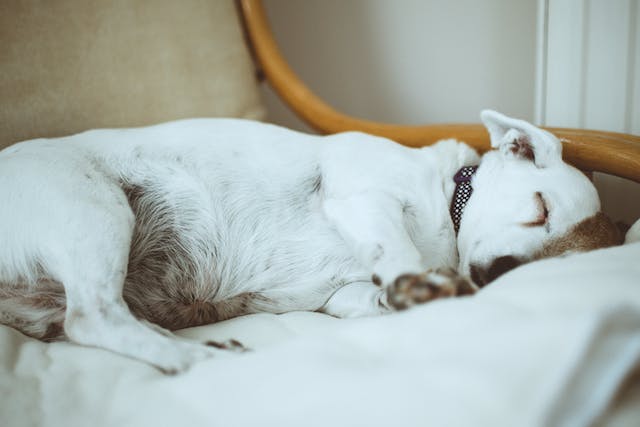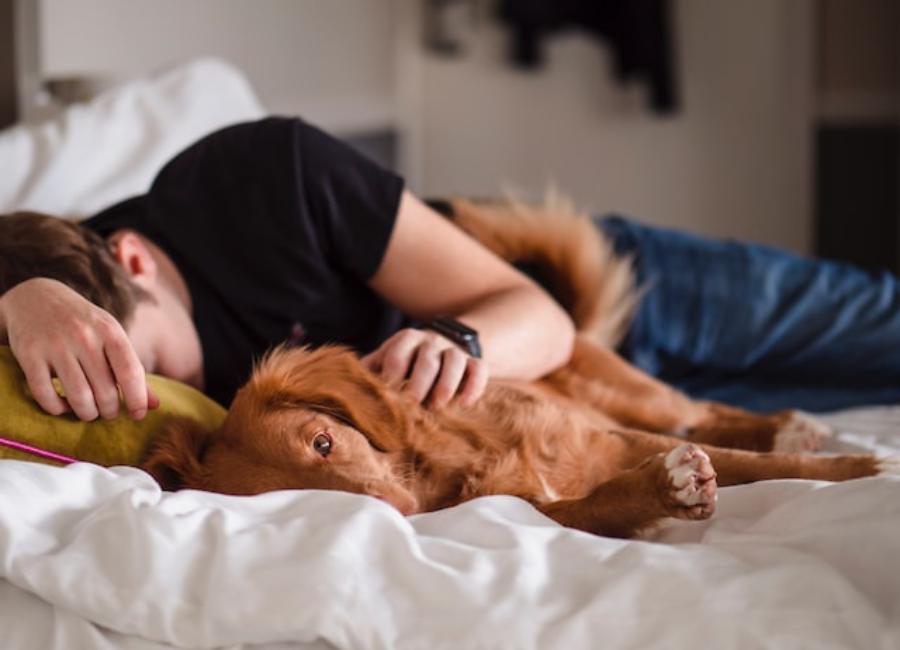Let’s find out how to get your dog to go to sleep…
Tired of those late-night zoomies keeping you up? Well, fret no more, because I’ve got some pawsome tips on how to get your furry friend to snooze like a champ.
So grab a cozy blanket, snuggle up, and let’s dive into the secrets of a peaceful pup slumber!
Why Your Dog May Not Want to Sleep
There could be several reasons why a dog may not want to sleep. Firstly, discomfort or pain could be a factor.
Dogs may avoid sleeping if they have underlying health issues, such as arthritis or gastrointestinal problems.
Secondly, anxiety or stress can disrupt a dog’s sleep patterns. Loud noises, separation anxiety, or changes in the environment can make them feel uneasy.
Thirdly, inadequate exercise or mental stimulation can lead to restlessness, making it difficult for dogs to settle down and sleep.
Additionally, external factors like temperature, lighting, or uncomfortable bedding can also discourage dogs from sleeping.
Lastly, it’s important to consider that individual dogs have unique preferences and personalities that may influence their sleep behavior.
How To Get Your Dog To Go To Sleep
From my years of experience living with dogs, to get your dog to go to sleep immediately, you need to quickly provide a dim light, calm, and comfortable sleeping room or spot with a cozy bed.
Then use relaxation techniques like gentle petting or calming music to help your dog relax and sleep off. Make sure to avoid stimulating activities or feeding your dog during the process.
Finally, be patient and consistent with your approach, as it may take time for your dog to adjust to any new sleeping routine.
Let’s break it down further…
Ways of Making Your Dog Go To Sleep

Getting your dog to go to sleep immediately can be a challenge, especially if they are energetic or easily distracted. However, there are several steps you can take to create a conducive environment for sleep.
The following are some of the common ways of making your dog go to sleep:
1. Set Up a Comfortable and Cozy Bed
Creating a comfortable and inviting sleeping area for your dog is essential. Provide a soft and supportive bed or blanket that your dog can snuggle into.
Consider choosing a bed that is appropriately sized for your dog’s breed and age, as well as one that suits their sleeping preferences (e.g., a plush bed for dogs that like to burrow or a raised bed for those that prefer a cooler surface).
Make sure the bedding is clean and free from any unpleasant odors. You might also consider using calming scents, such as lavender, which can help promote relaxation in dogs.
2. Dim Every Light Around the Sleeping Spot
Dogs are sensitive to light, and bright lights can stimulate them and keep them awake. To promote sleepiness, ensure that the environment around your dog’s sleeping spot is dimly lit.
Close curtains or blinds to block out external light sources, and consider using a nightlight or low-level ambient lighting if complete darkness is not possible.
By reducing the amount of light, you create a calm and relaxing atmosphere that encourages your dog to wind down and rest.
3. Eliminate All Forms of Distractions Around the Sleeping Spot
Just like humans, dogs can be easily distracted by noises, movement, or other environmental factors. Minimizing distractions will help your dog focus on sleep.
Choose a quiet room or corner of your home where your dog can retreat and relax without being disturbed. Close windows to reduce outside noises, turn off the television or any loud appliances and ask family members to keep their voices down.
Additionally, if there are other pets in the house, separate them during bedtime to prevent any play or interaction that could keep your dog awake.
4. Lay Down Close to Your Dog and Pretend to Sleep
Dogs are pack animals and often find comfort in being close to their owners. By lying down next to your dog and pretending to sleep, you can create a sense of calm and security that encourages them to relax and fall asleep.
Make sure you choose a comfortable spot where your dog feels safe and secure, such as their bed or a designated sleeping area.
5. Avoid Intense Activities Before Bedtime

Just like humans, dogs need a wind-down period before bedtime. Engaging in intense activities or play sessions right before bed can make it difficult for them to settle down.
Instead, try to establish a calming routine in the evening. You can engage in gentle activities like a leisurely walk, some quiet playtime, or a brief training session that focuses on relaxation exercises.
This helps to gradually transition your dog from an active state to a more relaxed one, making it easier for them to fall asleep.
6. Try a Potty Break Before Bed
The need to relieve themselves can often disrupt a dog’s sleep. To prevent any nighttime accidents or restlessness, take your dog for a potty break shortly before bedtime.
This ensures that their bladder is empty, reducing the chances of them waking up due to discomfort or the need to go outside.
Make sure to establish a consistent potty routine, including a final trip outside before settling down for the night.
7. Give Your Dog Gentle Petting and Cuddles
Physical touch and affection can help to calm your dog and prepare them for sleep. Spend some time gently petting and cuddling your dog before bedtime.
This can help them feel secure and relaxed, encouraging them to settle down and fall asleep. Focus on areas that your dog enjoys being touched, such as their back or behind the ears.
8. Limit Food and Water Before Bed
Just like humans, dogs can have difficulty sleeping on a full stomach. To prevent your dog from feeling restless or needing to go outside during the night, it’s best to limit their food and water intake before bedtime.
Avoid feeding them a large meal just before sleep and remove their water bowl a couple of hours before bedtime.
This will give their digestive system time to settle and reduce the likelihood of them needing to go outside during the night.
9. Play Soothing Music or White Noise

Sound can have a significant impact on your dog’s ability to relax and fall asleep. Playing soothing music or white noise can help drown out any external noises that may be keeping your dog alert or anxious.
Look for calming instrumental music or specially designed dog sleep soundtracks available on streaming platforms or through pet-specific apps.
Alternatively, you can use a white noise machine or a fan to create a consistent background noise that can help your dog relax and fall asleep.
Frequently Asked Questions
My dog just won’t settle down at night. What can I do to help them fall asleep?
There are a few strategies you can try to help your dog relax and fall asleep. Establishing a bedtime routine, providing a comfortable sleeping area, and engaging in calming activities before bed can all help your dog wind down and get ready for sleep.
Should I let my dog sleep in my bed?
Whether or not you allow your dog to sleep in your bed is a personal choice. However, it’s important to consider if it’s affecting your quality of sleep or causing behavioral issues. If your dog’s presence in your bed is disruptive, it may be best to provide them with their own cozy sleeping space.
My dog is anxious at night and struggles to fall asleep. Any tips to help with this?
If your dog experiences anxiety at night, there are a few things you can try. Creating a calm and soothing environment, using calming aids such as lavender essential oil or a weighted blanket, and providing a safe space for your dog to retreat to can all help alleviate their anxiety and promote better sleep.
Is exercise important for helping my dog sleep better?
Yes, regular exercise is crucial for a good night’s sleep for your dog. Physical activity helps to tire them out, both mentally and physically, making it easier for them to relax and fall asleep. Aim for daily walks or play sessions to ensure your dog gets the exercise they need.
Should I feed my dog before bedtime or limit water intake?
It’s generally recommended to avoid feeding your dog a large meal right before bedtime to prevent discomfort or digestive issues. However, a small snack or treat a couple of hours before bed can be beneficial. As for water intake, it’s important to provide access to fresh water throughout the day but consider limiting water intake closer to bedtime to minimize nighttime bathroom breaks.
My dog snores loudly at night. Is this normal?
Some dogs are prone to snoring, and it’s usually harmless. However, if your dog’s snoring is accompanied by other symptoms like difficulty breathing or excessive daytime sleepiness, it’s best to consult with a veterinarian to rule out any underlying health issues.
Conclusion
So, there you have it, folks! Getting your furry friend to sleep peacefully is all about creating a cozy and consistent bedtime routine, providing a comfortable sleeping space, and ensuring they get enough exercise during the day. With a little bit of patience and love, you’ll have your dog snoozing soundly in no time. Sweet dreams, both for you and your four-legged companion!

